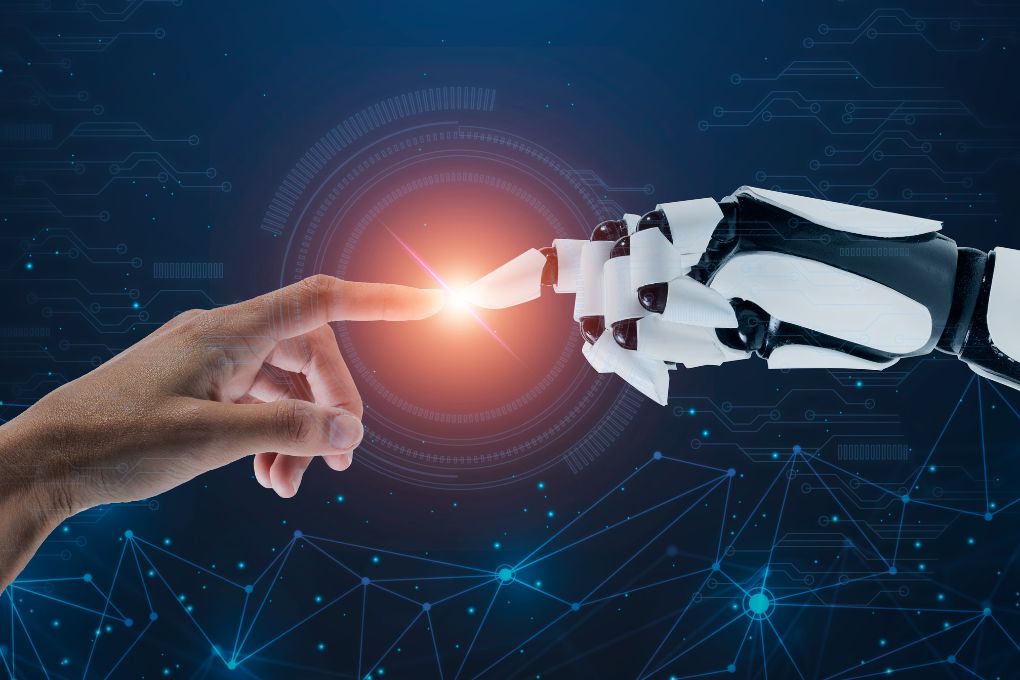
Artificial intelligence (AI), or artificial intelligence in English, is a complex term that describes the ability of machines to think and act similarly to humans. AI can be used to perform tasks usually done by humans. These include tasks that require human knowledge or abstraction. AI systems combine algorithms, programming, and data to analyze input data and deliver corresponding results.
In this blog article, we explore the basics of AI, various applications and uses, and the advantages and disadvantages of AI-based technology. We also examine what AI depends on to function correctly and complete the assigned task. We’ll also look at whether there are some tasks that AI can’t do or still needs to understand fully. Finally, let’s look at some examples of using artificial intelligence daily.
What is Artificial Intelligence (AI)?
Artificial intelligence (AI) refers to the ability of computers and machines to perform tasks that would typically require human intelligence. It is an interdisciplinary research and application discipline that builds on the foundations of computer science, mathematics, statistics, cognitive psychology, and other disciplines. With AI, computer programs that imitate human knowledge, abstraction skills, and behavior can be created. AI systems combine algorithms, programming, and data to analyze input data and deliver corresponding results.
Due to their ability to learn and adapt, AI systems are widely used to perform complex tasks across various application domains. Examples include the automated control of robots, natural language processing, computer vision, or solving complex problems such as medical diagnoses. AI is a very diverse field, and there is still a lot of research and development to improve it further.
Exploring the basics of AI – understanding the programming language
To use artificial intelligence (AI), you have to understand programming. An essential part of understanding AI is understanding the mathematical foundations and algorithms used to develop the programs.
Various programming languages can be used for AI applications. A well-known language is Python, a high-level programming language that is easy to learn and great for AI applications. Other languages like Java, C++, or Lisp can also program AI systems.
Various libraries are specifically designed for AI applications, such as TensorFlow and Scikit-Learn. They can be used to simplify programming AI systems and reduce development time.
Artificial intelligence (AI) is based on two essential components: machine learning and neural networks. Machine learning describes a wide range of algorithms used to recognize patterns in data and build models based on those patterns. Neural networks are a special algorithm that uses a layered network of nodes to simulate the system’s behavior.
Two other components of AI are natural language processing (NLP or natural language processing) and computer vision. Natural language processing involves processing natural language to perform tasks such as recognizing input data or producing answers. With NLP, computer programs can naturally follow human dialogue and adapt to the context of a conversation.
Computer vision involves understanding images and videos by recognizing and interpreting their information. Computer vision allows programs to recognize events in a video stream, such as movements, colors, or shapes. Computer vision can also detect objects in images and determine their location in space.
A solid understanding of the programming language is crucial for AI researchers to design, implement, and optimize AI algorithms. It is a fundamental tool for fully exploiting the possibilities of artificial intelligence and developing innovative solutions.
The advantages and disadvantages of AI-based technology
Artificial intelligence (AI) has both advantages and disadvantages.
Advantages of AI-based technology:
Automation and efficiency: This allows human resources to be used for more demanding tasks.
Data analysis and pattern recognition: AI systems can process large amounts of data and identify patterns, trends, and relationships that are difficult for human analysts to see.
Personalized Experiences: AI can deliver personalized content, recommendations, and experiences by analyzing and learning from individual users’ behavior and preferences.
Error reduction and quality improvement: often less prone to errors than human workers.
Advances in various industries.
Disadvantages of AI-based technology:
Job losses: Automation through AI can lead to job losses, especially in areas where machines replace human labor.
Ethical and privacy concerns: AI raises questions about ethical responsibility and protecting privacy and data. AI technologies require clear guidelines and regulations to avoid abuse, discrimination, and data breaches.
Dependence on technology: Over-reliance on AI-based systems can lead to problems if they are faulty, hacked (IT security), or react unexpectedly.
Lack of human intuition and creativity: Often needs an understanding of context, intuition, and creativity that influence human decisions and innovation.
Costs and resources: developing and implementing the required software and programs can be costly.
AI-based technologies offer many opportunities, but some disadvantages must be considered. Although AI benefits many areas, decisions should always be carefully considered before using it.
What does AI depend on to function correctly and complete the assigned task?
For AI to function properly and complete tasks successfully, it must have sufficient data. AI requires precise and relevant data to make correct decisions. The more data an AI system has, the better it can perform its tasks.
AI also requires suitable algorithms to be adjusted to the data to perform specific tasks. Training an AI system to process new situations and data properly is also necessary. An AI system must be trained correctly to produce correct results.
Finally, the excellent performance of the AI application is critical. The better the AI system performs, the better it can perform tasks and deliver the desired results. Optimizing this performance usually requires much computing effort and time to develop the required software and programs.
In conclusion, AI must function properly to complete specific tasks. It must have sufficient data, suitable algorithms, correct training, and good performance.
Are there tasks the AI cannot do or does not yet fully understand?
There are some tasks that AI does not fully understand and, therefore, cannot complete. For example, it is not yet possible for AI to recognize the intention or motivation behind an action. Another problem is distinguishing between reality and fantasy, as AI systems do not have accurate intuition.
Although there have been many recent advances in AI research, there are still tasks that AI still needs to understand fully. These tasks include complex natural language input, interpreting irony or sarcasm, and recognizing emotions. Analyzing the deeper meaning of a text is also tricky for AI because it needs help understanding the context of the conversation.
In conclusion, AI is a powerful and versatile technology, but there are also tasks that it cannot do or still needs to understand fully. Although AI continues to improve, some problems still need to be solved before it can perform all tasks.
Conclusion
Artificial intelligence (AI) is a powerful and versatile technology that has found its way into many areas of everyday life. Although AI is not perfect, and there are still some challenges to overcome, it can have a lot of impact thanks to its ability to adapt to different contexts and situations. With the proper research and knowledge, AI can surpass human capabilities and solve many different problems.
Also Read : OpenAI Announces The Arrival Of New Features For ChatGPT





